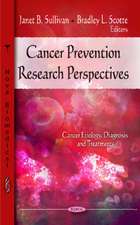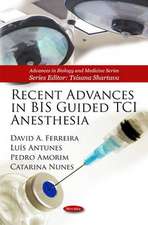Introduction to MATLAB® for Biologists: Learning Materials in Biosciences
Autor Cerian Ruth Webb, Mirela Domijanen Limba Engleză Paperback – 14 aug 2019
Examples presented within the book are selected to be relevant to biological scientists and they illustrate some of the many ways the program can be incorporated into, and used to enhance, your own research and studies.
The textbook is a must-have for students and researchers in the biological sciences. It will also appeal to readers of all backgrounds who are looking for an introduction to MATLAB which is suitable for those with little or no experience of programming.
Din seria Learning Materials in Biosciences
- 17%
 Preț: 394.87 lei
Preț: 394.87 lei - 20%
 Preț: 506.67 lei
Preț: 506.67 lei - 5%
 Preț: 529.76 lei
Preț: 529.76 lei - 5%
 Preț: 338.37 lei
Preț: 338.37 lei - 5%
 Preț: 330.24 lei
Preț: 330.24 lei -
 Preț: 347.48 lei
Preț: 347.48 lei - 5%
 Preț: 561.90 lei
Preț: 561.90 lei - 17%
 Preț: 426.67 lei
Preț: 426.67 lei - 17%
 Preț: 457.75 lei
Preț: 457.75 lei - 5%
 Preț: 491.25 lei
Preț: 491.25 lei - 17%
 Preț: 457.84 lei
Preț: 457.84 lei - 17%
 Preț: 490.60 lei
Preț: 490.60 lei -
 Preț: 358.42 lei
Preț: 358.42 lei - 17%
 Preț: 424.90 lei
Preț: 424.90 lei - 5%
 Preț: 414.82 lei
Preț: 414.82 lei - 17%
 Preț: 458.25 lei
Preț: 458.25 lei - 13%
 Preț: 383.66 lei
Preț: 383.66 lei - 5%
 Preț: 797.65 lei
Preț: 797.65 lei - 20%
 Preț: 345.73 lei
Preț: 345.73 lei - 5%
 Preț: 797.65 lei
Preț: 797.65 lei - 17%
 Preț: 428.12 lei
Preț: 428.12 lei - 5%
 Preț: 671.48 lei
Preț: 671.48 lei - 19%
 Preț: 397.76 lei
Preț: 397.76 lei -
 Preț: 339.79 lei
Preț: 339.79 lei - 15%
 Preț: 527.97 lei
Preț: 527.97 lei - 19%
 Preț: 477.45 lei
Preț: 477.45 lei - 5%
 Preț: 583.95 lei
Preț: 583.95 lei - 19%
 Preț: 436.50 lei
Preț: 436.50 lei - 15%
 Preț: 494.85 lei
Preț: 494.85 lei - 15%
 Preț: 466.45 lei
Preț: 466.45 lei - 15%
 Preț: 494.85 lei
Preț: 494.85 lei - 5%
 Preț: 524.95 lei
Preț: 524.95 lei - 15%
 Preț: 533.72 lei
Preț: 533.72 lei - 15%
 Preț: 528.99 lei
Preț: 528.99 lei -
 Preț: 353.65 lei
Preț: 353.65 lei - 5%
 Preț: 595.01 lei
Preț: 595.01 lei - 15%
 Preț: 476.75 lei
Preț: 476.75 lei - 15%
 Preț: 527.48 lei
Preț: 527.48 lei
Preț: 527.89 lei
Preț vechi: 555.67 lei
-5% Nou
Puncte Express: 792
Preț estimativ în valută:
101.01€ • 105.75$ • 83.58£
101.01€ • 105.75$ • 83.58£
Carte tipărită la comandă
Livrare economică 01-07 aprilie
Preluare comenzi: 021 569.72.76
Specificații
ISBN-13: 9783030213367
ISBN-10: 3030213366
Pagini: 182
Ilustrații: XIII, 175 p. 30 illus., 27 illus. in color.
Dimensiuni: 168 x 240 mm
Greutate: 0.44 kg
Ediția:1st ed. 2019
Editura: Springer International Publishing
Colecția Springer
Seria Learning Materials in Biosciences
Locul publicării:Cham, Switzerland
ISBN-10: 3030213366
Pagini: 182
Ilustrații: XIII, 175 p. 30 illus., 27 illus. in color.
Dimensiuni: 168 x 240 mm
Greutate: 0.44 kg
Ediția:1st ed. 2019
Editura: Springer International Publishing
Colecția Springer
Seria Learning Materials in Biosciences
Locul publicării:Cham, Switzerland
Cuprins
Introduction: What is Matlab and what can it be used for.- Overview of Interface.- Toolboxes.- The basics using the command line: Element by element versus matrix multiplication.- Multiplying and dividing arrays of data.- Example 1: Next generation matrix models.- Creating and using script files: Debugging scripts.- Using the live editor.- Accessing help.- Exploring Matlab’s in-built functions.- Creating graphs and plots: Example 1: Introduction to the image processing toolbox.- Example 2: Plotting ellipses, hyperbola and parabola (conic sections).- Anonymous functions.- Creating separate function files: Example 1: solving a differential equation using ode45 using biological examples.- Importing and exporting data: Example 1: reading spreadsheets using the command line and an application of linear algebra to statistical analysis of qpcr data.- Matlab as a programming language: Introduction to using loops in your scripts.- For loops.- While loops.- Combining loops and conditional statements.
Notă biografică
- Cerian R. Webb: Cerian Webb graduated with a degree in pure Mathematics from the University of York, followed by an MSc in Mathematical Biology from the University of Dundee. She completed her PhD at the Department of Plant Sciences, University of Cambridge, modelling crop growth and disease dynamics. Cerian lectures on undergraduate courses in Mathematical Biology at the University of Cambridge and is a lecturer on the Wellcome Genome Campus Advanced Course 'Mathematical Models for Infectious Disease Dynamics'. She regularly delivers a course on MATLAB for biologists through the University of Cambridge School of Biological Sciences Bioinformatics Training Facility. Cerian is currently a post-doctoral research associate in the Epidemiology and Modelling Group, Department of Plant Sciences, University of Cambridge and is the Associate Lecturer in Mathematical Biology at Newnham College, Cambridge.
Mirela Domijan: Mirela Domijan completed her undergraduate and MPhil studies in Mathematics at the University of Waikato, her PhD at the University of Warwick and she held postdoctoral posts at Warwick and at the University of Cambridge. At present she is a lecturer in Applied Mathematics in the Department of Mathematical Sciences at the University of Liverpool. She has lectured courses in Mathematical Biology and Systems Biology and, during her time at the University of Cambridge, she taught MATLAB at the university’s School of Biological Sciences Bioinformatics Training Facility. Her research focuses on application of mathematics to plant biology.
Textul de pe ultima copertă
This textbook takes you from the very first time you open MATLAB® through to a position where you can comfortably integrate this computer language into your research or studies. The book will familiarise you with the MATLAB interface, show you how to use the program´s built-in functions and carefully guide you towards creating your own functions and scripts so that you can use MATLAB as a sophisticated tool to support your own research. A central aim of this book is to provide you with the core knowledge and skills required to become a confident MATLAB user so that you can find and make use of the many specialist functions and toolboxes that have been developed to support a wide range of biological applications.
Examples presented within the book are selected to be relevant to biological scientists and they illustrate some of the many ways the program can be incorporated into, and used to enhance, your own research and studies.
The textbook isa must-have for students and researchers in the biological sciences. It will also appeal to readers of all backgrounds who are looking for an introduction to MATLAB which is suitable for those with little or no experience of programming.
Examples presented within the book are selected to be relevant to biological scientists and they illustrate some of the many ways the program can be incorporated into, and used to enhance, your own research and studies.
The textbook isa must-have for students and researchers in the biological sciences. It will also appeal to readers of all backgrounds who are looking for an introduction to MATLAB which is suitable for those with little or no experience of programming.
Caracteristici
The reader is made confident using the various sources of help available in Matlab and online The book introduces ways in which Matlab is used in biological research other than data analysis With examples from the biological sciences The reader will understand the basic programming methods and will learn to import and export data standard sets The reader will be able to manipulate the date and create plots to use script files to group commands and create simple functions use many of Matlab's in-built functions



























